Does Elliptical Training Build Muscle?
Author:
Reviewed by:
(21 years of Oly Lifting experience)
Unlock your full potential by engaging with our experts and community! Have questions about your fitness journey or looking for expert advice on weightlifting techniques? Don’t hesitate — leave a comment below and Ihor Shymechko will provide a personalized answer and insights to help you reach your goals.
Torokhtiy is reader-supported. Some links are affiliate links, and we may earn a commission at no extra cost to you. See our disclosure page for details.
Ellipticals provide an excellent low-impact cardio choice that burns calories, improves cardiovascular health, and is easy to perform. Whilst the health and fitness benefits are well established, do ellipticals build muscle? I’ve explained the muscles worked, factors influencing muscle building, and how to effectively use an elliptical below.
Do Ellipticals Build Muscle? Elliptical strength training can be used to tone your upper and lower body by increasing the resistance to a suitable level. This needs to be done alongside the correct strength training and the right diet to build muscle.
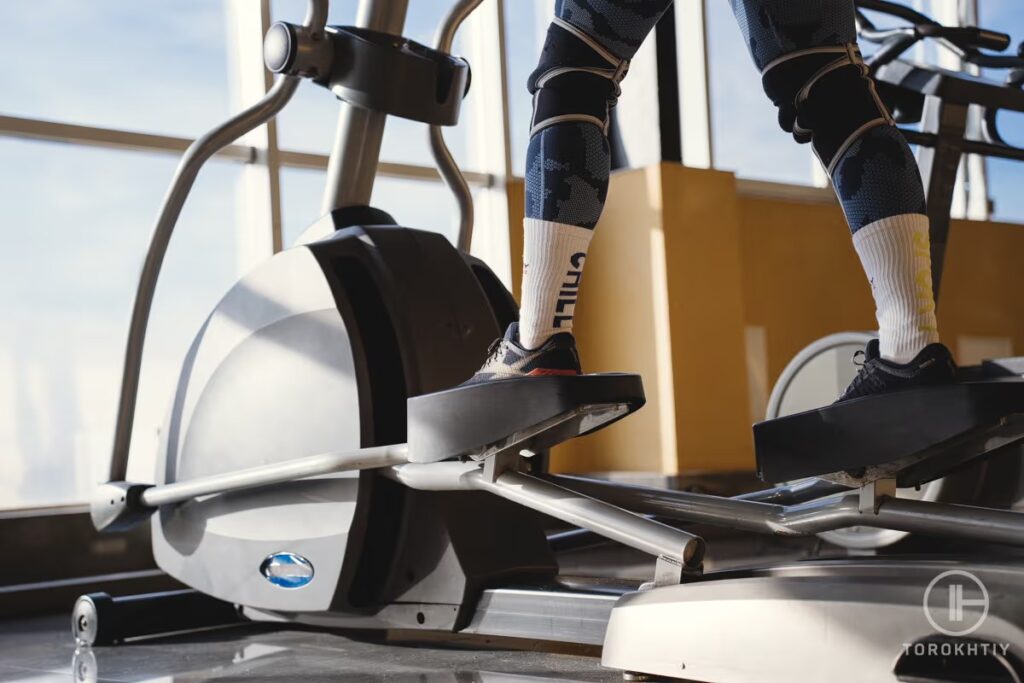
What Muscles Does the Elliptical Work?
An elliptical machine combines the movements of an exercise bike, stepper, and treadmill. It uses a low-impact arc-like motion with your arms and legs working together or separately depending on what you choose. The elliptical resistance can be increased to provide an additional challenge or decreased for a more cardio-based workout. With this, can an elliptical build muscle?
As a full-body exercise, an elliptical provides a great way to tone your muscles. Let’s take a quick look at some of the muscles worked in more detail:
Lower Body Muscles
1. Quads
The quads are located at the front of the thighs opposite the hamstrings. They comprise four different muscles that each carry out a different function.
Each time you transfer weight to push down on the pedals, your quads contract. The higher the elliptical elevation, the more your quads will need to work.
2. Glutes
The glute muscles are located at the back of the leg above the hamstrings and opposite the quads. They consist of three muscles that vary in shape and function..
During the elliptical motion, the glutes are engaged in the forward and backward motion. They help to propel the body upwards as you move from a bent to a straight leg position and lower back down under control.
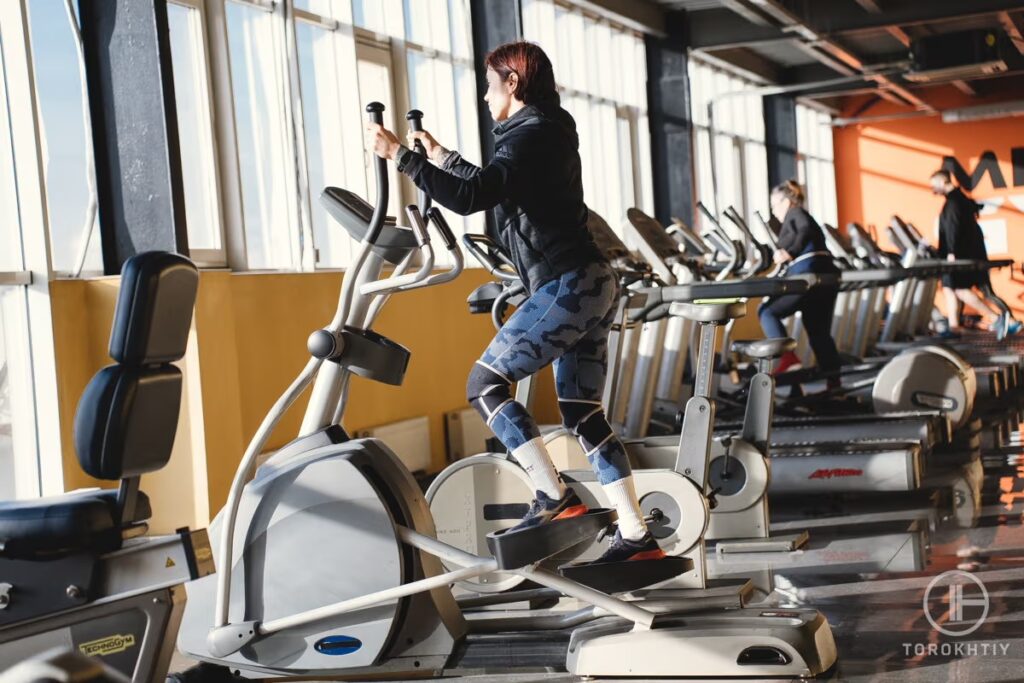
3. Hamstrings
The hamstrings are located below the glutes and consist of three muscles that play a crucial role in dynamic, powerful movements.
Similar to the quads, the hamstrings play an active role in both the forward and backward elliptical motion. The help to drive the legs forward and and return to the starting position in a controlled manner.
4. Calves
The calves are located at the back of your lower leg and consist of two muscles. They work by stabilizing your legs throughout the elliptical movement.
During the downward phase, you have to press through the balls of your feet. It’s here that the calf’s plantar flex to assist the quads to move correctly.
Tips From the Champ
The ProForm Carbon EL Elliptical is part of ProForm’s mid-level Carbon range. It offers an interactive elliptical that’s designed around user comfort and an immersive workout experience.
Olympic Weightlifting Champion
Upper Body
Your upper body muscles work alongside your core to push and pull the elliptical handles.
1. Chest, Triceps, and Shoulders
As you push the elliptical handles, your chest, triceps, and shoulders contract. This brings the elliptical handles forward whilst your legs move backwards. Each arm does this seperate to the other, with the leg performing the opposite action.
2. Back and Biceps
Your back and biceps are responsible for the elliptical pull phase. Once you’ve pushed the handles forward, your back and biceps pull to bring the handles back toward your body. As you do this, your corresponding leg drives forward.
Core Muscles
1. Core and Abdominals
Throughout the movement, your core and abdominal muscles work to keep your body from moving out of the optimal push and pull position. Your core and abs should at all times during the movement.
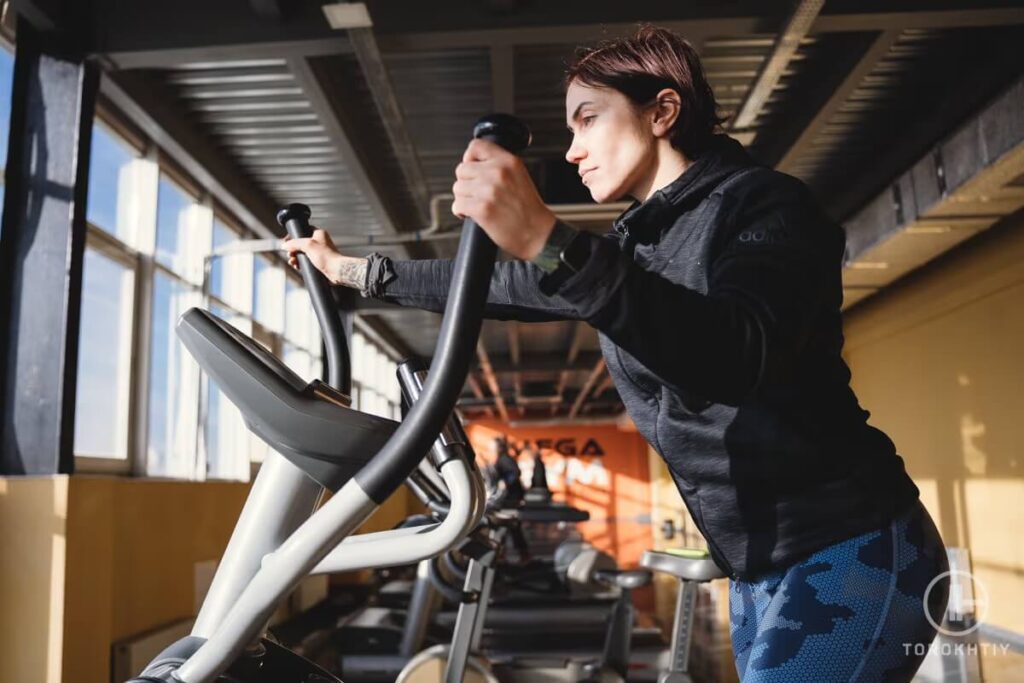
2. Lower Back
Your lower back muscles work alongside your core and abs to keep your body upright. This involves maintaining a neutral spine position with your head up and chest out.
What Influences Muscle Building When Using an Elliptical?
Muscle building is a complicated process that requires several different processes to work together. Whilst the elliptical provides a muscle-building stimulus, other factors need to be taken into account.
1. Nutrition
Building muscle requires a well-planned, consistent nutrition strategy that provides you with enough of the essential nutrients your body needs to grow. This should be alongside a well-organized elliptical training routine.
The main three macronutrients are proteins, fats, and carbohydrates. Protein is the key muscle-building macronutrient, with essential amino acids playing a main role in muscle-building and recovery.
Examples of good quality proteins include lean meats, eggs, some red meat, fish, nuts, beans, and legumes.
Carbohydrates provide the critical energy needed for high-intensity, long-duration resistance training sessions. Without carbohydrates, your body can struggle to get the energy it needs. Fueling up correctly before and after a training session is important, especially if you’re performing two in quick succession.
Examples of good carbohydrate sources include potatoes, pasta, fruit, starchy vegetables, rice, and quinoa.
Fats play a lesser role in muscle building but are still important for hormone and immune system functioning. Good fats include avocados, olives, whole eggs, and nuts.
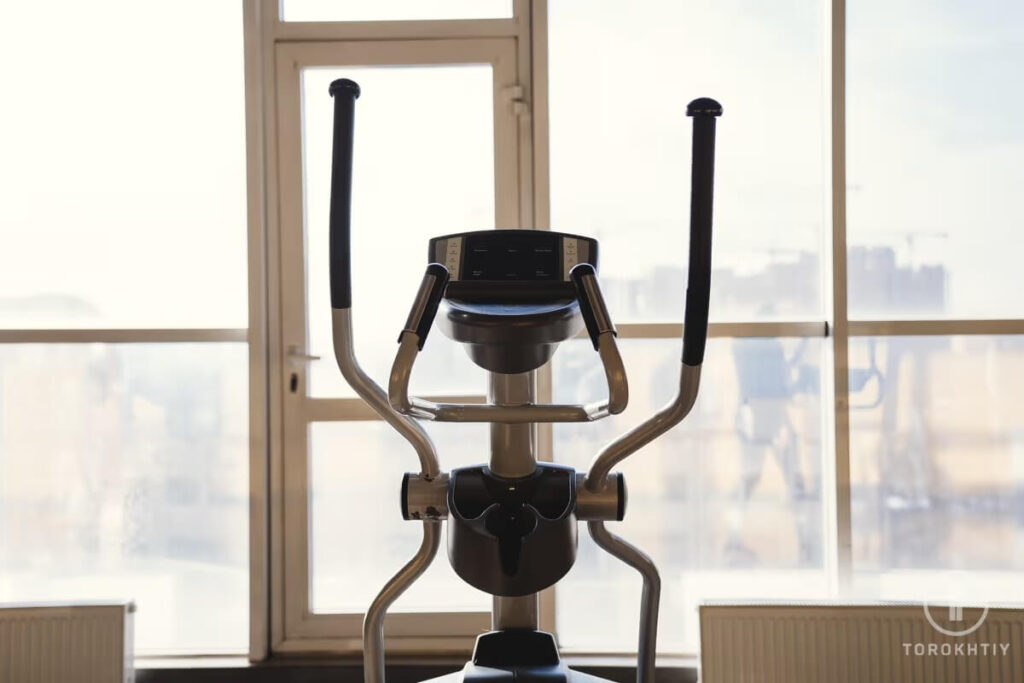
2. Strength Training
In order for muscles to grow, you need to provide a sufficient stimulus. This can be done via muscle tension, muscle damage, or metabolic stress.
Each of these mechanisms works by creating a stress that is different from the previous one your body is already adapted to. Lifting heavier weights provides increased muscle tension. Performing an intense training session leads to muscle damage. Increased time under tension leads to metabolic stress.
Strength training needs to be performed in order to promote muscle building alongside using an elliptical as part of a well-organized health and fitness routine.
3. Calorie Surplus
The international society of sports nutrition states that there needs to be sufficient calories available in order for someone to build muscle. Consuming an adequate amount of calories is important for gaining muscle and also supporting the resistance training sessions that help to provide the muscle-building stimulus.
How to Use an Elliptical Machine for Muscle Building?
Building muscle by using an elliptical isn’t just as simple as getting on the machine. You need to know what you’re wanting to accomplish and what other factors may influence the session quality or muscle-building processes.
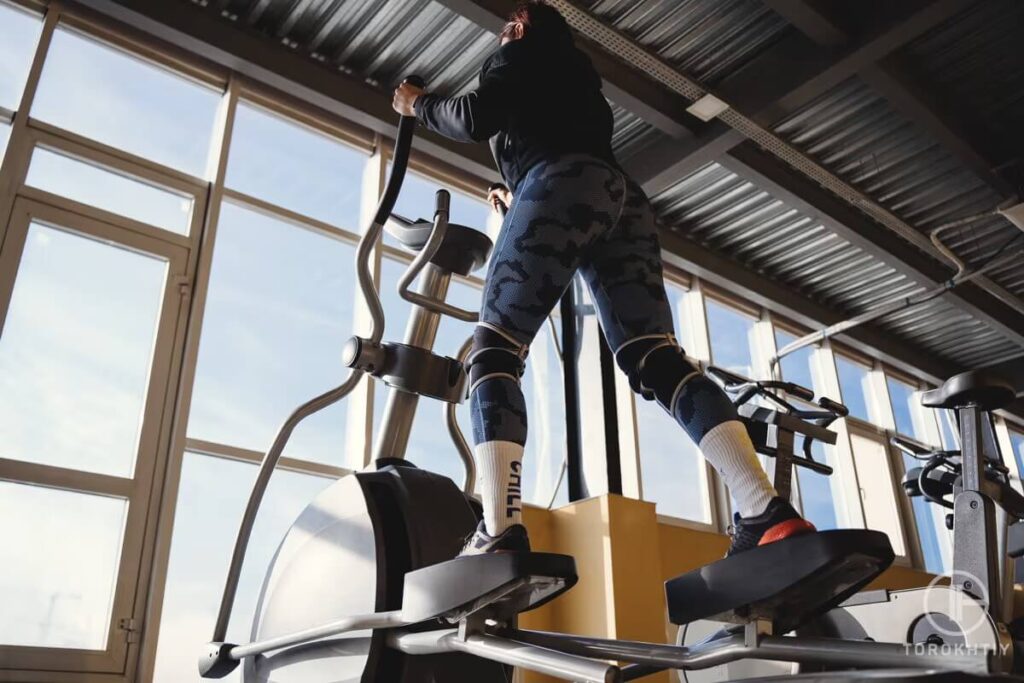
1. Cardio and Strength Training
Alongside the factors I’ve discussed above, the elliptical can complement muscle building using several different training methods. I’ll go through a couple of the main ones below:
- High Intensity Interval Training (HIIT) – If you’re looking to build muscle and burn a lot of calories at the same time, this training method is a great option. It works by combining periods of maximum effort with rest intervals, with a set number of rotations to perform. Using the elliptical, try performing 8-10 rounds of 30-second bursts with 20 seconds of rest in between. Set the resistance at a level that feels very hard for the full 30 seconds. Most ellipticals also have built-in workout programs that have a HIIT mode you can use if you prefer more structure.
- Elliptical Incline Training – Most ellipticals have an incline feature that allows you to change the angle at which the pedals move to provide an added challenge. Start by warming up for 5-10 minutes using the normal elliptical motion at a low RPE. Start to increase the elliptical incline and set a workout goal whether it be time, distance, or number of calories. To primarily target your quads and glutes keep a forward motion. Pedal backward if you want to engage your hamstrings and calves more.
2. Recovery Day Training
For your recovery day training, you want to be performing low intensity steady state cardio alongside some good-quality stretching.
Your recovery day should be complimenting the muscle-building efforts that have already taken place, not hinder them. Recovery days are a chance for you to rest mentally and physically and provide an extra calorie-burning opportunity when done correctly.
With the elliptical, look to perform 30-45 minutes of low-intense cardio at a pace where you feel comfortable talking still. Use an RPE of around 3 and look to add some stretches in at the end.
Elliptical Machine We Recommend
The ProForm Carbon EL Elliptical is part of ProForm’s mid-level Carbon range. It offers an interactive elliptical that’s designed around user comfort and an immersive workout experience.
Each purchase of the EL includes a 3-year iFit membership which provides you with thousands of live and on-demand trainer-led workout classes from the comfort of your own home.
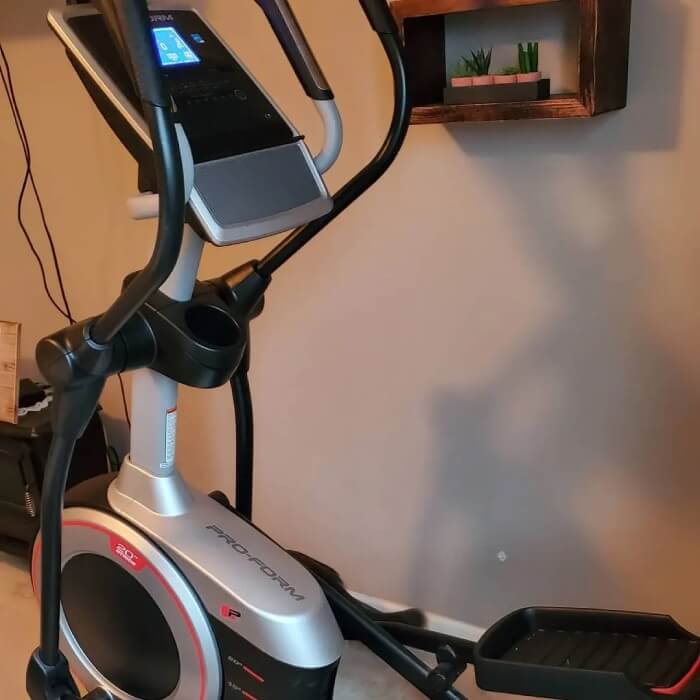
With 24 resistance levels to choose from using ProForm’s patented SMR silent magnetic resistance, the EL offers a huge range of workout options and operates very quietly.
The Carbon EL offers excellent functionality and comfort with a 19″ adjustable stride length, oversized foot pedals, and a handy water bottle holder. It has dual 2″ BlueTooth speakers and front transport wheels for easy portability
FAQ
Is It Enough To Use The Elliptical Only To Build Muscle?
Elliptical training won’t help you to build muscle as quickly as weight training will, but it can still provide a decent stimulus for toning.
Use the elliptical on a high resistance alongside weight training and a good diet if you want to build muscle.
What Muscles Are Toned by an Elliptical?
When used normally by operating the handles and foot pedals, ellipticals can work your full body. Lower body muscles worked include your quads, hamstrings, calves, and glutes. Your shoulder and arms are used to push and pull the elliptical handles.
Can Elliptical Training Give You Abs?
Elliptical training doesn’t necessarily give you abs, but it can help when used alongside the right diet and other abdominal training exercises.
During the elliptical motion, your abdominals need to work to keep your body upright.
Does the Elliptical Bulk Your Legs?
Elliptical training can help to build lower body muscle size alongside a well-planned nutritional regimen and strength training program. You need to be in a calorie surplus to put in good-quality muscle size.
Conclusion
Ellipticals are fantastic cardio machines that provide a low-impact way to burn calories, tone your muscles, and improve your cardiovascular fitness.
Whilst they provide a muscle-building stimulus, other factors such as nutrition and weight training need to be taken into account.
What do you think about using an elliptical for muscle building? What training methods do you use? What’s your favorite elliptical workout? Tell me below and I’ll answer any of your questions!
Also read:
- What Muscles Used on Elliptical
- Benefits of Elliptical
- Best Commercial Elliptical
- Best Compact Elliptical
- How Much Does an Elliptical Cost
References:
- International Society of Sports Nutrition Position Stand: protein and exercise // Tandfonline: https://www.tandfonline.com/doi/full/10.1186/s12970-017-0177-8
- International Society of Sports Nutrition position stand: Nutrient timing // Tandfonline: https://www.tandfonline.com/doi/full/10.1186/1550-2783-5-17
- A healthy approach to dietary fats: understanding the science and taking action to reduce consumer confusion // Nutritionj: https://nutritionj.biomedcentral.com/articles/10.1186/s12937-017-0271-4
- How do muscles grow? // Unm: http://www.unm.edu/~lkravitz/Article%20folder/musclesgrowLK.html
- The mechanisms of muscle hypertrophy and their application to resistance training // Pubmed: https://pubmed.ncbi.nlm.nih.gov/20847704/
- International society of sports nutrition position stand: diets and body composition // Tandfonline: https://www.tandfonline.com/doi/full/10.1186/s12970-017-0174-y
- WHAT IS LISS CARDIO & SHOULD YOU BE DOING IT? // Setforset: https://www.setforset.com/blogs/news/liss
- Rated Perceived Exertion (RPE) Scale // Clevelandclinic: https://my.clevelandclinic.org/health/articles/17450-rated-perceived-exertion-rpe-scale
Why Trust Us?
With over 20 years in Olympic weightlifting, strength training, nutrition coaching, and general fitness our team does its best to provide the audience with ultimate support and meet the needs and requirements of advanced athletes and professional lifters, as well as people who strive to open new opportunities and develop their physical capabilities with us.
By trusting the recommendations of our certified experts in coaching, nutrition, and sports training programming, as well as scientific consultants, and physiotherapists, we provide you with thorough, well-considered, and scientifically proven content. All the information given in the articles concerning workout programming, separate exercises, and athletic performance, in general, is based on verified data.
The product testing process is described in more detail here.
Author: Ihor Shymechko
Pro Olympic Weightlifter, Coach
Best Results: Snatch – 208 kg,
C&J – 240 kg
Ihor has been a professional weightlifter since 1996, boasting over two decades of competition experience. His notable achievements include clinching the European Championship in 2009 and securing a silver medal in the 105kg division at the Senior World Championships in 2011. Ihor represented his country in the 2008, 2012, and 2016 Summer Olympics. After retiring from competitive weightlifting, he transitioned to coaching, leveraging his vast experience to guide athletes who now compete on both national and international stages.
Reviewed by: Oleksiy Torokhtiy
Olympic Weightlifting Champion, PhD in Sport Science
Best Results: Snatch – 200 kg,
C&J – 240 kg
Oleksiy Torokhtiy is a professional athlete boasting 20 years of experience in Olympic weightlifting. With multiple European and World titles under his belt, he has showcased his prowess in two Olympic Games (Beijing 2008 and London 2012). Upon concluding his illustrious career, Oleksiy dedicated himself to coaching. By 2022, he had conducted over 200 weightlifting seminars worldwide. He is the visionary behind an international sportswear and accessories brand known for its motto, “Warm Body Cold Mind.” Additionally, he is an esteemed author and the creator of a series of training programs and eBooks.





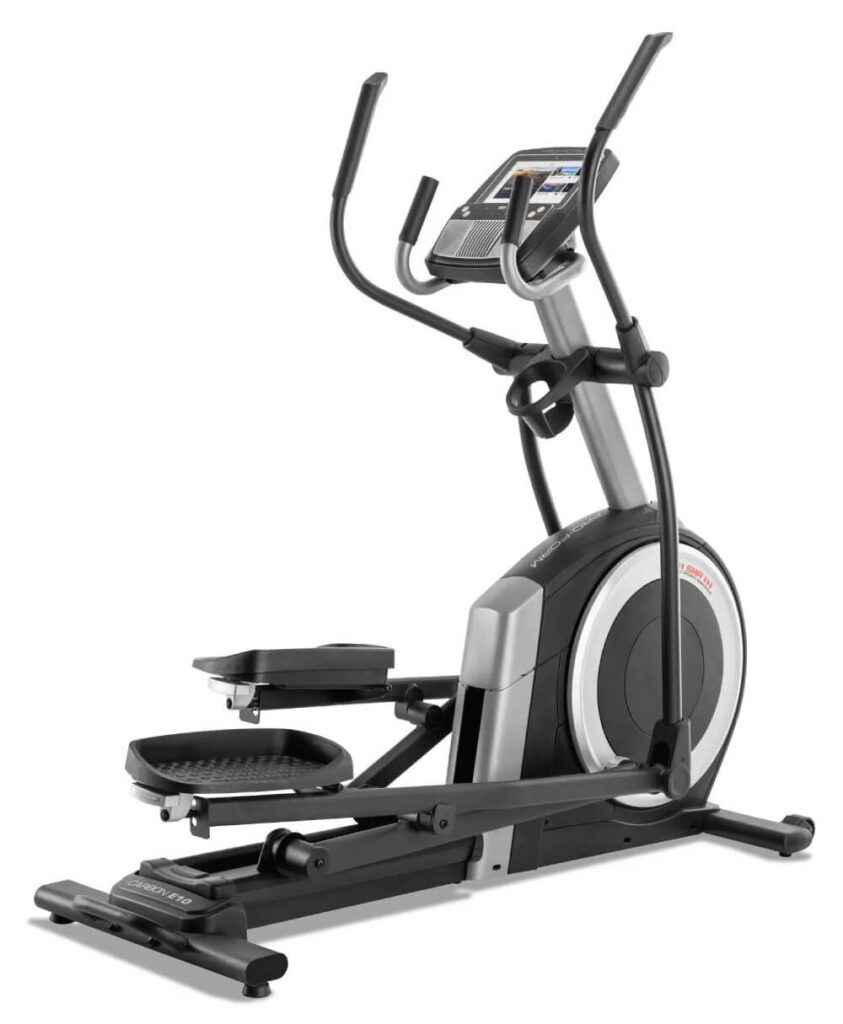
Still have questions after reading our article? Unlock your full potential by engaging with our experts and community! Don’t hesitate — leave a comment below and Ihor Shymechko will provide a personalized answer and insights to help you reach your goals.